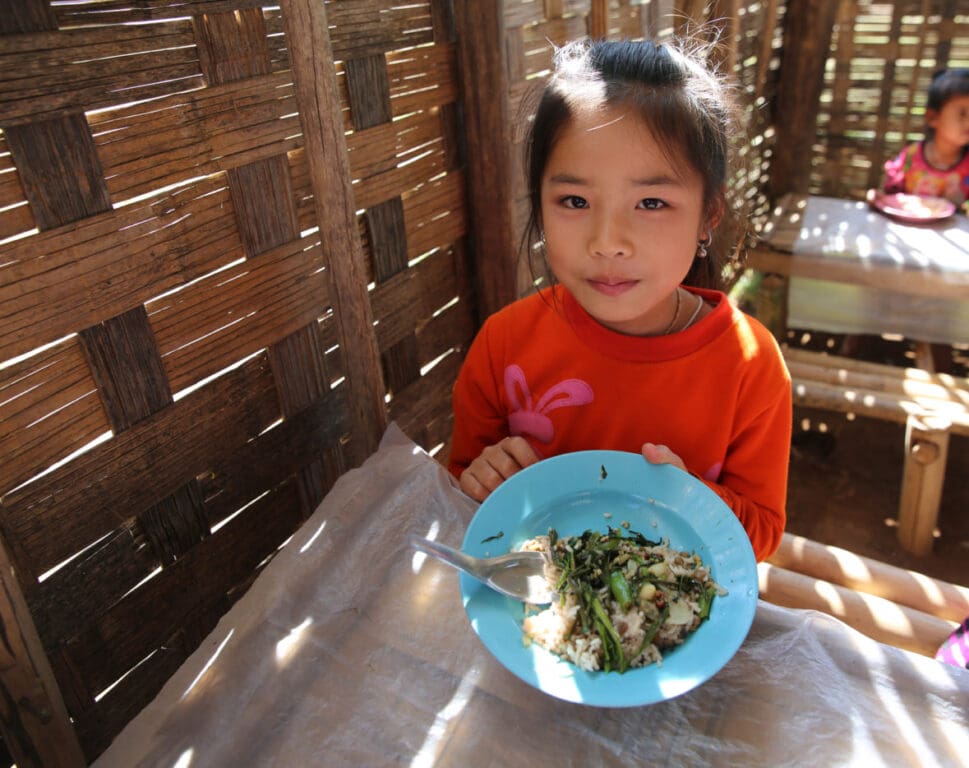Food Donation From the U.S. Helps Children Stay in School and Learning

Vientiane – Rice and lentils from the United States arrived in Laos this week and were received by the U.S. Ambassador to Lao PDR, Dr. Peter M. Haymond, today at WFP’s Vientiane warehouse.
The donation consists of 68 containers of rice and 4 containers of lentils (1,290 metric tons in total) and will be used to cook school lunches for some 90,000 primary school children in rural areas of Lao PDR starting with the next term in September. For many children, this plate of hot food is the only daily nutritious meal they will receive, a meal that they had to manage without during the recent seven-week school closures due to the COVID pandemic.
“I am so proud that despite the challenges everyone is facing during the COVID-19 pandemic, the United States is continuing to support daily school lunches for primary school students in the Lao PDR. School lunches are proven to help students achieve better academic results, and encourage higher attendance for all students, especially females and underrepresented groups. The United States stands together with the people and the Government of Laos to support the pursuit of this country’s development goals,” said Ambassador Haymond.
Since 2008, the U.S. Government’s McGovern-Dole Food for Education and Child Nutrition Program, which is administered by the U.S. Department of Agriculture (USDA), has been supporting WFP school meals program in Laos. With a total of more than $60 million contribution, McGovern-Dole has helped more than 1.5 million children access daily nutritious lunches through WFP’s school meals program.
In order to shift to long-term, nationally-run school feeding programs, WFP has started handing over the supported schools to the government, with about 500 schools already integrated into the national school meals program to date. WFP is continuing to provide technical assistance to the government beyond the handover. In addition, WFP has made extra efforts to ensure and widen local supply of food to schools and community ownership. A specific program, also supported by USDA, has focused on linking school meals to local agricultural production. Currently, all 925 WFP-supported schools receive contributions of vegetables and greens from local farmers and school gardens.
“WFP’s school meals program is a social safety net for many poor and vulnerable families in Laos,” said Jan Delbaere, WFP Country Director and Representative. “We have learned that during the lockdown, poor households have the most acute challenges in accessing food. As schools are gradually reopening, we are attaching utmost importance to safe, hygienic standards and physical distancing measures all throughout our logistics chain up to the delivery of school meals in the villages. At the same time, we are doing our best to ensure families can keep their children in school by guaranteeing a healthy school meal. We are thankful for the United States as our long-standing partner in support of school children and rural families in Laos, especially in these uncertain times,” he said.
# # #
The United Nations World Food Programme – saving lives in emergencies and changing lives for millions through sustainable development. WFP works in more than 80 countries around the world, feeding people caught in conflict and disasters, and laying the foundations for a better future.
Follow us on Twitter @wfp_media @WFPUSA
For more information please contact:
- Ildiko Hamos, Partnerships and Communications Coordinator, ildiko.hamos@wfp.org, Tel. +856 (0)21 330 300 ext. 2229
- Vilakhone Sipaseuth, Communications Officer, vilakhone.sipaseuth@wfp.org, Tel. +856 (0)21 330 300 ext. 2930




